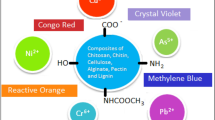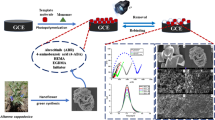Abstract
A molecularly imprinted photoelectrochemical sensor with high sensitivity and stable structure was constructed and applied to detect thiamethoxam pesticide. ZnO/Bi2O3/Bi2S3 heterojunction photoelectric material was formed on the fluorine-doped tin oxide (FTO) electrode by seed layer growth, drip coating, and in situ ion exchange. A chitosan-imprinted polymer membrane was prepared using chitosan as the functional monomer, glutaraldehyde as the cross-linking agent, and thiamethoxam as the template molecule. The photoelectric material was characterized by X-ray diffraction, scanning electron microscopy, and energy dispersive x-ray spectroscopy analyses. The electron transfer mechanism of Z-type heterojunction was verified by ultraviolet–visible curve and Mott-Schottky curve. When thiamethoxam was re-adsorbed on the imprinted membrane, the current recorded at 0 V (vs. Ag/AgCl) was reduced because the thiamethoxam molecule blocked the electron transfer. The molecularly imprinted sensor exhibited a linear relationship to thiamethoxam concentration in the range from 7.0 × 10−13 mol/L to 7.0 × 10−10 mol/L and the detection limit was 3.32 × 10−13 mol/L, which is lower than the values reported by other detection methods. Most pesticides, such as propoxur and isoprocarband carbaryl, do not interfere with the determination. The sensor also showed good practicability and suitability for the determination of trace thiamethoxam in environmental water and soil leaching solutions, with a recovery of 99.6–102.1% (RSD < 3.74%).
Graphical abstract
A novel molecularly imprinted photoelectrochemical (MI-PEC) sensor with high sensitivity and selectivity for the determination of thiamethoxam (TMX) was developed. A Z-type heterojunction ZnO/Bi2O3/Bi2S3 photoelectric material was synthesized for the first time. The MI-PEC sensor was prepared with ZnO/Bi2O3/Bi2S3 as the sensitive material and MI membrane as the recognition element. The sensor exhibits an extremely sensitive response to thiamethoxam with a detection limit of 3.32 × 10−13 mol/L due to the excellent photoelectrochemical properties of ZnO/Bi2O3/Bi2S3








Similar content being viewed by others

References
Wang X, Ji R, Chen R (2019) Research on thiamethoxam detection and ultraviolet degradation modeling based on fluorescence analysis. Optik 176:476–481. https://doi.org/10.1016/j.ijleo.2018.07.100
Xu T, Xu QG, Li H, Wang J, Li QX, Shelver WL, Li J (2012) Strip-based immunoassay for the simultaneous detection of the neonicotinoid insecticides imidacloprid and thiamethoxam in agricultural products. Talanta 101:85–90. https://doi.org/10.1016/j.talanta.2012.08.047
Camargo C, Snow DD, Onanong S, Hunt TE, Siegfried BD (2019) Residues of thiamethoxam and mefenoxam in vegetative and floral tissue of soybean at the early reproductive stage resulting from seed treatments. Crop Protect 119:134–140. https://doi.org/10.1016/j.cropro.2019.01.019
Watanabe E, Eun H, Baba K, Arao T, Ishii Y, Endo S, Ueji M (2004) Rapid and simple screening analysis for residual imidacloprid in agricultural products with commercially available ELISA. Anal Chim Acta 521(1):45–51. https://doi.org/10.1016/j.aca.2004.05.056
Sun X, Wei H, Young DE, Bein KJ, Smiley-Jewell SM, Zhang Q, Fulgar CCB, Castaneda AR, Pham AK, Li W, Pinkerton KE (2017) Differential pulmonary effects of wintertime California and China particulate matter in healthy young mice. Toxicol Lett 278:1–8. https://doi.org/10.1016/j.toxlet.2017.07.853
Qiu Y, Li J, Li H, Zhao Q, Wang H, Fang H, Fan D, Wang W (2015) A facile and ultrasensitive photoelectrochemical sensor for copper ions using in-situ electrodeposition of cuprous oxide. Sens Actuators B Chem 208:485–490. https://doi.org/10.1016/j.snb.2014.11.061
Botelho CN, Pavao e Pavao D, Damos FS, Silva Luz RdC (2021) Photoelectrochemical sensor for isoniazid: application in drugs used in the treatment of tuberculosis. Electroanalysis 33(8):1936–1944. https://doi.org/10.1002/elan.202100023
Tian J, Zhao P, Zhang S, Huo G, Suo Z, Yue Z, Zhang S, Huang W, Zhu B (2020) Platinum and iridium oxide co-modified TiO2 nanotubes array based photoelectrochemical sensors for glutathione. Nanomaterials (Basel) 10(3). https://doi.org/10.3390/nano10030522
Cossuet T, Appert E, Thomassin J-L, Consonni V (2017) Polarity-dependent growth rates of selective area grown ZnO nanorods by chemical bath deposition. Langmuir 33(25):6269–6279. https://doi.org/10.1021/acs.langmuir.7b00935
Liu L, Ou H, Hong K, Wang L (2018) Evidence of a strong electron-hole separation effect in ZnO@TiO2 core/shell nanowires. J Alloys Compd 749:217–220. https://doi.org/10.1016/j.jallcom.2018.03.184
Ning P, Liang J, Li L, Chen D, Qin L, Yao X, Chen H, Huang Y (2021) In situ growth of Z-scheme CuS/CuSCN heterojunction to passivate surface defects and enhance charge transport. J Colloid Interface Sci 590:407–414. https://doi.org/10.1016/j.jcis.2020.12.126
Li X, Garlisi C, Guan Q, Anwer S, Al-Ali K, Palmisano G, Zheng L (2021) A review of material aspects in developing direct Z-scheme photocatalysts. Mater Today 47:75–107. https://doi.org/10.1016/j.mattod.2021.02.017
Zhu C, Gong T, Xian Q, Xie J (2018) Graphite-like carbon nitride coupled with tiny Bi2S3 nanoparticles as 2D/0D heterojunction with enhanced photocatalytic activity. Appl Surf Sci 444:75–86. https://doi.org/10.1016/j.apsusc.2018.03.021
Jiang L, Yuan X, Zeng G, Liang J, Chen X, Yu H, Wang H, Wu Z, Zhang J, Xiong T (2018) In-situ synthesis of direct solid-state dual Z-scheme WO3/g-C3N4/Bi2O3 photocatalyst for the degradation of refractory pollutant. Appl Catal B 227:376–385. https://doi.org/10.1016/j.apcatb.2018.01.042
Zhang Y, Hao N, Zhou Z, Hua R, Qian J, Liu Q, Li H, Wang K (2017) potentiometric resolved ratiometric photoelectrochemical aptasensor. Chem Commun 53(43):5810–5813. https://doi.org/10.1039/c7cc01582h
Wei X, Wu T, Yuan Y, Ma X, Li J (2017) Highly sensitive analysis of organometallic compounds based on molecularly imprinted electrochemical sensors. Anal Methods 9(11):1771–1778. https://doi.org/10.1039/c6ay03320b
Bai X, Zhang Y, Gao W, Zhao D, Yang D and Jia N (2020) Hollow ZnS-CdS nanocage based photoelectrochemical sensor combined with molecularly imprinting technology for sensitive detection of oxytetracycline. Biosens Bioelectron 168. https://doi.org/10.1016/j.bios.2020.112522
Li X, Zhong L, Liu R, Wei X, Li J (2019) A molecularly imprinted photoelectrochemical sensor based on the use of Bi2S3 for sensitive determination of dioctyl phthalate. Mikrochim Acta 186(11). https://doi.org/10.1007/s00604-019-3812-z
Li Z, Hu J, Lou Z, Zeng L, Zhu M (2021) Molecularly imprinted photoelectrochemical sensor for detecting tetrabromobisphenol A in indoor dust and water. Mikrochim Acta 188(10). https://doi.org/10.1007/s00604-021-04980-1
Xi J, Wang H, Zhang B, Zhao F, Zeng B (2020) Novel molecularly imprinted photoelectrochemical sensor for rutin based on Bi2S3/ZnIn2S4 heterojunction. Sens Actuators B Chem 320. https://doi.org/10.1016/j.snb.2020.128409
Gao B, Liang Z, Han D, Han F, Fu W, Wang W, Liu Z, Niu L (2021) Molecularly imprinted photo-electrochemical sensor for hemoglobin detection based on titanium dioxide nanotube arrays loaded with CdS quantum dots. Talanta 224. https://doi.org/10.1016/j.talanta.2020.121924
Karimi-Maleh H, Yola ML, Atar N, Orooji Y, Karimi F, Kumar PS, Rouhi J, Baghayeri M (2021) A novel detection method for organophosphorus insecticide fenamiphos: molecularly imprinted electrochemical sensor based on core-shell Co3O4@MOF-74 nanocomposite. J Colloid Interface Sci 592:174–185. https://doi.org/10.1016/j.jcis.2021.02.066
Shi X-X, Li X-Q, Wei X-P, Li J-P (2020) Molecularly imprinted photoelectrochemical sensor based on AgBiS2/Bi2S3 for determination of propoxur. Chinese J Anal Chem 48(3):396–404. https://doi.org/10.19756/j.issn.0253-3820.191608
Wang R, Yan K, Wang F, Zhang J (2014) A highly sensitive photoelectrochemical sensor for 4-aminophenol based on CdS-graphene nanocomposites and molecularly imprinted polypyrrole. Electrochim Acta 121:102–108. https://doi.org/10.1016/j.electacta.2013.12.139
Zouaoui F, Bourouina-Bacha S, Bourouina M, Jaffrezic-Renault N, Zine N, Errachid A (2020) Electrochemical sensors based on molecularly imprinted chitosan: a review. TrAC, Trends Anal Chem 130. https://doi.org/10.1016/j.trac.2020.115982
Liu Q, Zhao Y, Pan J, Van der Bruggen B, Shen J (2016) A novel chitosan base molecularly imprinted membrane for selective separation of chlorogenic acid. Sep Purif Technol 164:70–80. https://doi.org/10.1016/j.seppur.2016.03.020
Atarodi H, Faghihian H (2019) Selective photodegradation of atrazine by a novel molecularly imprinted nanophotocatalyst prepared on the basis of chitosan. J Photochem Photobiol A 382. https://doi.org/10.1016/j.jphotochem.2019.111892
Petkova P, Francesko A, Fernandes MM, Mendoza E, Perelshtein I, Gedanken A, Tzanov T (2014) Sonochemical coating of textiles with hybrid ZnO/chitosan antimicrobial nanoparticles. ACS Appl Mater Interfaces 6(2):1164–1172. https://doi.org/10.1021/am404852d
Feng J, Jiang T, Han Y, Okoth OK, Cheng L, Zhang J (2020) Construction of dual Z-scheme Bi2S3/Bi2O3/WO3 ternary film with enhanced visible light photoelectrocatalytic performance. Appl Surf Sci 505.https://doi.org/10.1016/j.apsusc.2019.144632
Chen Y, Zhang Y, Luo L, Shi Y, Wang S, Li L, Long Y, Jiang F (2018) A novel templated synthesis of C/N-doped beta-Bi2O3 nanosheets for synergistic rapid removal of 17 alpha-ethynylestradiol by adsorption and photocatalytic degradation. Ceram Int 44(2):2178–2185. https://doi.org/10.1016/j.ceramint.2017.10.173
Wu S, Dai X, Cheng T, Li S (2018) Highly sensitive and selective ion-imprinted polymers based on one-step electrodeposition of chitosan-graphene nanocomposites for the determination of Cr(VI). Carbohydr Polym 195:199–206. https://doi.org/10.1016/j.carbpol.2018.04.077
Wang H, Liang D, Xu Y, Liang X, Qiu X, Lin Z (2021) A highly efficient photoelectrochemical sensor for detection of chlorpyrifos based on 2D/2D beta-Bi2O3/g-C3N4 heterojunctions. Environ Sci Nano 8(3):773–783. https://doi.org/10.1039/d0en01243b
Viter R, Kunene K, Genys P, Jevdokimovs D, Erts D, Sutka A, Bisetty K, Viksna A, Ramanaviciene A, Ramanavicius A (2020) Photoelectrochemical bisphenol S sensor based on ZnO-nanoroads modified by molecularly imprinted polypyrrole. Macromol Chem Phys 221(2). https://doi.org/10.1002/macp.201900232
Ajermoun N, Farahi A, Lahrich S, Bakasse M, Saqrane S, Abderrahim El Mhammedi M (2019) Electrocatalytic activity of the metallic silver electrode for thiamethoxam reduction: application for the detection of a neonicotinoid in tomato and orange samples. J Sci Food Agric 99(9):4407–4413. https://doi.org/10.1002/jsfa.9675
Pietrzak D, Wator K, Pekala D, Wojcik J, Chochorek A, Kmiecik E, Kania J (2019) LC-MS/MS method validation for determination of selected neonicotinoids in groundwater for the purpose of a column experiment. J Environ Sci Health B 54(5):424–431. https://doi.org/10.1080/03601234.2019.1574173
Norouzi P, Ghaheri N, Aghazadeh M, Mofidi Z, Larijani B (2017) Sensitive electrochemical measurement of thiamethoxam on nanocomposite coated carbon paste using FFT coulometric admittance voltammetry and flow injection analysis. Int J Electrochem Sci 12(10):8847–8859. https://doi.org/10.20964/2017.10.45
Xie T, Zhang M, Chen P, Zhao H, Yang X, Yao L, Zhang H, Dong A, Wang J, Wang Z (2017) A facile molecularly imprinted electrochemical sensor based on graphene: application to the selective determination of thiamethoxam in grain. Rsc Adv 7(62):38884–38894. https://doi.org/10.1039/c7ra05167k
Funding
The authors acknowledge the support given by the National Natural Science Foundation of China (No. 21765006), the Natural Science Foundation of Guangxi Province of China (No. 2021GXNSFAA196011), and the Guangxi Colleges and Universities Key Laboratory of Food Safety and Detection, China.
Author information
Authors and Affiliations
Corresponding authors
Ethics declarations
Conflict of interest
The authors declare no competing interests.
Additional information
Publisher's note
Springer Nature remains neutral with regard to jurisdictional claims in published maps and institutional affiliations.
Supplementary information
Below is the link to the electronic supplementary material.
Rights and permissions
About this article
Cite this article
Xiao, W., Wang, L., Wei, X. et al. Chitosan-based molecularly imprinted photoelectric sensor with ZnO/Bi2O3/Bi2S3 sensing layer for thiamethoxam determination. Microchim Acta 189, 247 (2022). https://doi.org/10.1007/s00604-022-05326-1
Received:
Accepted:
Published:
DOI: https://doi.org/10.1007/s00604-022-05326-1



